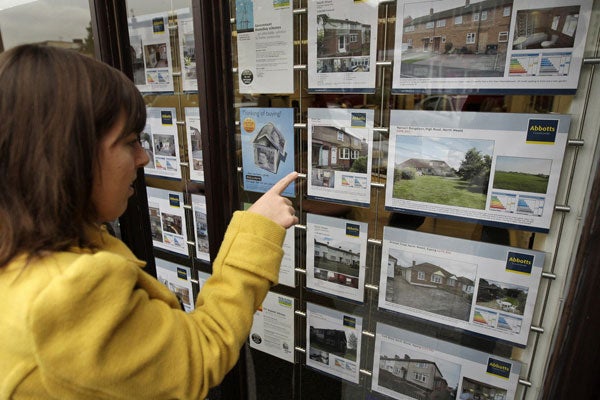Home loans up by a quarter

Your support helps us to tell the story
From reproductive rights to climate change to Big Tech, The Independent is on the ground when the story is developing. Whether it's investigating the financials of Elon Musk's pro-Trump PAC or producing our latest documentary, 'The A Word', which shines a light on the American women fighting for reproductive rights, we know how important it is to parse out the facts from the messaging.
At such a critical moment in US history, we need reporters on the ground. Your donation allows us to keep sending journalists to speak to both sides of the story.
The Independent is trusted by Americans across the entire political spectrum. And unlike many other quality news outlets, we choose not to lock Americans out of our reporting and analysis with paywalls. We believe quality journalism should be available to everyone, paid for by those who can afford it.
Your support makes all the difference.Mortgage lending jumped by 26 per cent during July as the housing market showed further signs of improving, figures showed today.
Around £16bn was advanced during the month, the highest figure for nine months and up from £12.7bn in June, according to the Council of Mortgage Lenders.
The group said the increase was further evidence of a modest improvement in the market after an exceptionally weak winter.
But it cautioned that activity still remained subdued by historic standards, with lending last month the lowest for July since 2001 and well down on the average of £27bn seen during the past seven years.
The CML said lending volumes had picked up in June and July as it had anticipated, due to the typically strong seasonal rise in activity over the summer.
It said the increase was likely to have been driven by a rise in people buying homes, as remortgaging activity continued to be limited by the low reversion rates people were put on to when their existing mortgage deal came to an end.
Paul Samter, CML economist, said: "Most of the indices point to house prices rising modestly over the summer months. The CML's July gross lending estimate of £16bn is the highest level in nine months and consistent with the rise in house purchase approvals.
"But the bounce-back in activity from the extreme weakness around the turn of the year, coinciding with a seasonal bounce, is limited in how far it can go against the current back-drop.
"We expect improved sentiment to support the market, but a further significant pick-up is unlikely with so many obstacles in place."
As a result, he said the group expected a slowdown in both lending volumes and property transactions during the latter part of the year, as a slow but more stable market emerged.
The Bank of England also released its monthly report on lending trends today, which showed the recovery in lending for house purchase had continued, but remortgaging activity remained "very subdued".
As a result, total net lending, which strips out redemptions and repayments, for July continued to be low.
The six major lenders questioned in the survey also said there had been no further improvement in the loan to value ratios they were prepared to lend on.
There had been signs that lenders were beginning to relax their lending criteria, reducing the size of the deposits they demanded in order for people to qualify for their best rates, as house prices stabilised. But this trend appears to have stalled.
Lenders also continued to raise the cost of their fixed rate mortgages during July, although several groups thought increased competition in the market may lead to lower margins being charged during the second half of the year.
On a brighter note, the groups reported an increase in the proportion of mortgages that were being approved, with the approval rate running at 80 per cent during July, up from around 70 per cent at the turn of the year.
There was also an increase in the number of mortgages being completed as property chains became less fragile.
The Bank's report also showed that lending to businesses declined further during July.
But lenders said some of the weakness was driven by a lack of demand as large companies raised money through the bond markets and by issuing shares.
Join our commenting forum
Join thought-provoking conversations, follow other Independent readers and see their replies
Comments